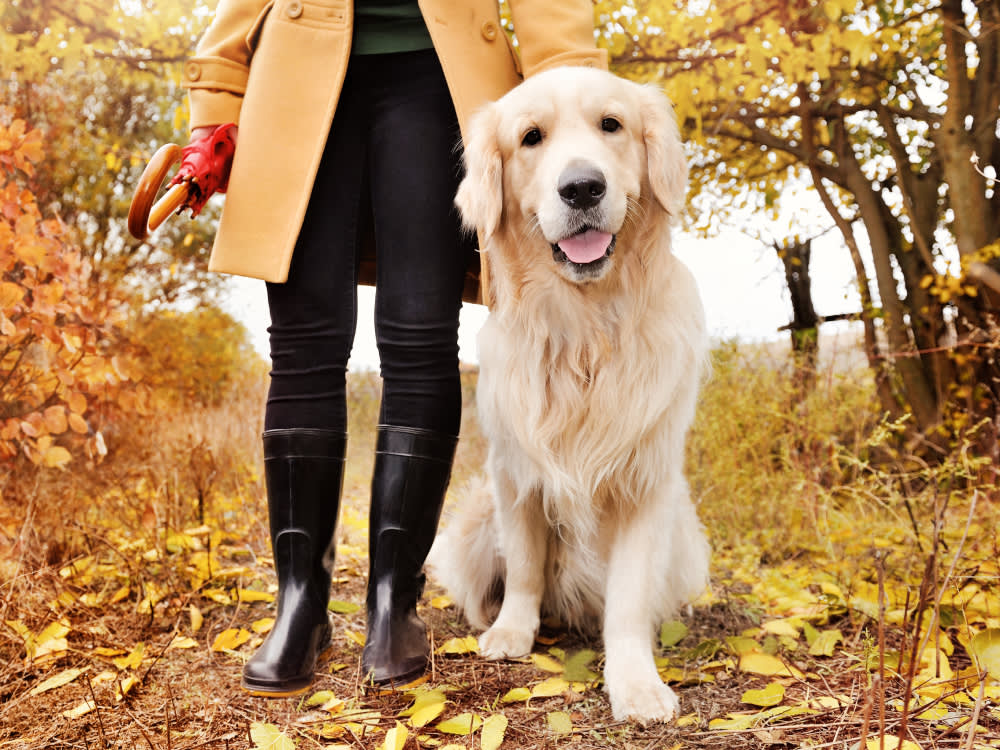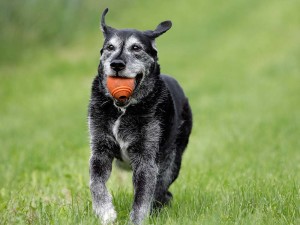Home Remedies for Dog Joint Pain Relief
DIY ways to help your pup cope with joint pain

share article
Nobody loves the physical effects of ageing – dogs included. Maybe you’ve noticed that your pup doesn’t hop out of their (your) bed in the morning anymore. Or maybe they’re reluctant to engage in the activities they used to love, like chasing a ball or jumping into the car for a rideopens in a new tab. These behavioural changes could be canine arthritis, an often painful and debilitating condition of the joints that affects at least 20 percent of adult dogs.
Canine arthritis cannot be cured, and it’s not always possible to prevent it, especially as your dog ages. There are, however, things you can do at home to help ease or even delay its onset. Weight management, supplements, gentle exercise and regular veterinary care make a difference. Paying attention to subtle signs of discomfort and making adjustments to your pup’s treatment as needed will help alleviate some of the pain.
What is canine arthritis?
Arthritis is inflammation within a joint, typically resulting in pain, stiffness and reduced mobility over time. The most common type is osteoarthritis (OA), a thinning and eventual deterioration of the protective tissues between the joints.
In a healthy joint, cartilage and other tissues act as shock absorbers that help with smooth movement and flexibility. As OA degrades these shock absorbers, joint tissues become damaged and release substances that cause painful inflammation. When cartilage breaks down, friction develops between the bones. OA most commonly affects a dog’s hips, elbows, knee joints (stifles) and lower back.
Causes of chronic joint pain
There are multiple causes of arthritis and chronic joint pain in dogs, which often occur in combination with one another. These include:
trauma from injury or repeated stress from high-impact athletic activity
obesity
pre-existing joint instability caused by anterior cruciate ligament (ACL) ruptures or hip dysplasia
genetics and anatomical conformationopens in a new tab (the way the body is formed, for example, short-legged, long-body breeds like Dachshunds, Bassets and English Bulldogs)
Certain larger breeds – including Labs, Golden Retrievers and German Shepherds – have a higher incidence of joint problems than some of the smaller breeds, but any dog can develop arthritis if the conditions are right.
How chronic joint pain in dogs is diagnosed
To determine whether your dog has joint pain due to osteoarthritis, your vet may use diagnostics such as:
a physical exam, to check for localised pain and swelling
radiographs and scans, to look for abnormalities
gait evaluation and limb manipulation, to assess mobility
joint-fluid analysis, to rule out other causes
Observation of your dog at home is another powerful diagnostic tool. Unless they’re experiencing acute, sharp pain, dogs rarely vocalise discomfort, so it’s important to monitor their habits and behaviouropens in a new tab. The symptoms of arthritis-related joint pain in dogs can be subtle in the early stages.
Be on the lookout for these other signs of joint pain in your dog:
decreased energy levels
sleeping more
reduced interest in physical activity
negative reactions to being petted or touched in specific areas
difficulty lying down or getting up
reluctance to climb stairs, jump on furniture or jump into the car
soiling accidents in the house
increased panting or drooling (may indicate stress or pain)
general irritability (chronic pain)
lameness/limping
vocalising with certain movements
How to treat chronic joint pain at home
At this point, there’s no cure for joint pain due to osteoarthritis, but there are an increasing number of options that can help with your dog’s pain, increase mobility and in some cases, slow the degeneration of joint cartilage. A multimodal treatment plan that includes a combination of medicine, supportive care and home remedies has been shown to be the most successful.
Consult with your veterinarian before introducing these home remedies into your dog’s treatment plan. Your vet can help you determine the most appropriate strategies for weight loss as well as other therapies.
Maintaining a healthy weightopens in a new tab is an essential component to managing osteoarthritis joint pain in dogs. Obese dogs are more likely to develop arthritis because excess weight puts more pressure on joints, leading to increased stress. It’s important to discuss your dog’s weight with your veterinarian and create a weight loss plan if needed.
At-home activities depend on the dog and the severity of their joint pain, but a 10-minute walk two or three times a day rather than one long walk is a good rule of thumb. Because excitement and activity release endorphins and adrenaline, dogs may feel less pain when exercising, allowing them to overdo it.
You can also gently massageopens in a new tab your dog’s sore spots to increase blood flow and apply alternating cold and heat to the affected areas.
Spending leisure time with your dog outdoors is also good medicine. Sunlight stimulates the body to produce vitamin D, which supports the immune system, reduces inflammation, strengthens joints and aids in calcium absorption. Enjoying some fresh air will also help your dog’s mood if pain has them feeling down.
Joint supplements such as glucosamine, chondroitin sulphate, MSM (methylsulfonylmethane) and others (see below) can be very helpful in reducing joint discomfort and may also allow reductions in the dosage and frequency of pharmaceutical drugs when used in combination. Whilst nutritional supplements are regulated by Food Supplements (England) Regulations (2003)opens in a new tab, and the equivalent regulations in Scotland, Wales and Northern Ireland, the quality and potency of supplements may vary, so it’s always a good idea to consult with your vet first for recommendations on which ones to try.
Best supplements for chronic joint pain
A list of supplements for dogs, though many products contain combinations of supplements on this list:
glucosamine
chondroitin sulphate
omega-3 fatty acids (fish oil)
MSM (methylsulfonylmethane)
Fortetropin (fertilised chicken egg yolk powder)
turmeric
sea cucumber
How can I help my arthritic dog live more comfortably with chronic joint pain?
Try these changes in your dog’s space to make living with arthritis easier.
Use portable ramps or steps for places your dog can no longer jump to.
Provide thick bedding, such as memory foam or an orthopaedic pad. Heated dog beds or dog-specific heating pads can also help with joint pain (the temperature should be warm but not hot to the touch). Make sure your dog’s bed is large enough for them to stretch out if they need to relieve pressure on sore joints.
To help your dog walk without slipping on uncarpeted floors, make a path with non-skid rugs or yoga mats (use individual extra-long mats, or look for 20m+ rolls of yoga mat material, available online).
Keep their nails and any excess fur around her paw pads trimmed. Paw pads are a dog’s built-in traction, but dry or worn-down pads don’t grip well; try a thin coating of a natural paw balm, or you can also make a DIY paw balm in your kitchen. Booties or toe grips are another option for better traction. (Your dog may need some time to get used to them.)
Raise food and water bowls off the floor so your dog doesn’t have to bend or strain at mealtime.
Use a lifting harness or support sling if your dog needs help getting up or has other mobility issues.
Alternative therapies
Acupuncture is increasingly popular for treating canine joint pain and can be beneficial for some dogs.
Physical therapy is essential to fighting the effects of osteoarthritis in dogs. Low-impact exercise strengthens the muscles around joints, helps keep joints mobile and reduces pain from stiffness. Some larger vet hospitals now provide a variety of physical therapy options such as ultrasound, shock wave and targeted Pulsed Electromagnetic Field (tPEMF) therapies, electrical stimulation, range-of-motion stretching, and cold-laser treatments.
Hydrotherapy (swimming in a warm-water pool or using an underwater treadmill) is a great low-impact exercise that improves muscle mass without over-stressing joints. Swimming in cold water, however, can be counterproductive, causing both joints and muscles to stiffen up.
Although there is no cure for canine arthritis, there are steps you can take to mitigate the effects of chronic joint pain at home by combining multiple elements of treatment, including pain control, weight management and low-impact exercise.
Disclaimer alert: this article is here to share information and should not be taken as fact or medical advice. Always talk things over with your vet when making decisions, and use your best judgement.

Abbie Deleers, LVT
Abbie Deleers is a licensed vet tech and founder of the nonprofit organization Vet Techs Without Bordersopens in a new tab. She enjoys traveling with animal rescue groups, swimming with sharks, and outdoor activities with her husband and their Siberian Husky in the beautiful Pacific Northwest.
Related articles
![shy dog frightened in the arms of the owner. this brown mixed-breed hound puppy has a sweet gaze. the female owner has a wool sweater]() opens in a new tab
opens in a new tabWhy is My Dog Shaking? Causes and Treatment
A vet explains why the weather isn’t always to blame
![Older dog playing with ball in a green field]() opens in a new tab
opens in a new tabDog Arthritis Treatment: How to Relieve Arthritis Pain in Dogs
Tips for treating achy joints – from medications to massages
![Dog biting his tail on a summer Baltic seashore.]() opens in a new tab
opens in a new tabUnderstanding Limber Tail Syndrome: Causes, Symptoms and Treatment
Seeing your pup’s normally perky tail go limp can be unnerving, but it’s really nothing to panic about
![Sad looking white boxer sitting on a chair at a wooden table]() opens in a new tab
opens in a new tab5 Tips for Helping Your Dog with Degenerative Myelopathy
The disease inhibits your dog’s ability to use their legs. One writer shares how the condition is diagnosed – and how you can help your dog stay mobile



